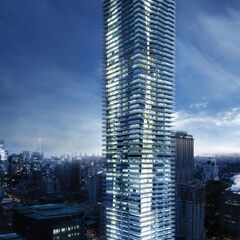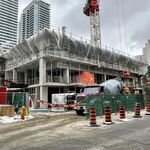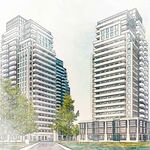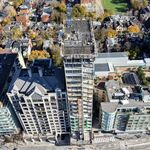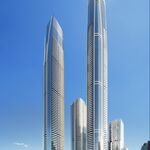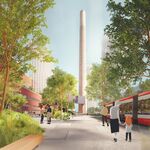Today we present a fourth installment in our interview series with the people behind One Bloor East by Great Gulf Homes, following Anna Simone who talked about the interior design at One Bloor earlier in the year, and more recently David Gerfosky, President and COO of Great Gulf Homes, and David Pontarini of Hariri Pontarini Architects.
At the groundbreaking ceremony we had the opportunity to sit down with Michael McGrath of builder Tucker Hi-Rise, construction managers for One Bloor. McGrath spoke to us about a new "5D" information modelling system designed by Tucker has called 'BEEM': Building Elements Execution and Modeling. This system is supposed to improve every stage of the construction process from planning through to execution, resulting in increased productivity and a shorter construction schedule.
 Michael McGrath and interviewer Dumitru Onceanu backstage at the One Bloor groundbreaking. Image by Craig White.
Michael McGrath and interviewer Dumitru Onceanu backstage at the One Bloor groundbreaking. Image by Craig White.
Is Tucker excited for this project?
Absolutely, it's been amazing just putting this whole thing together, from the history of the project with the previous developer, and then taking that plan and completely redesigning it.
You were involved with the first plan as well?
No, I was not involved with that one. When Great Gulf got involved in the project, we became a consultant in the due diligence period. We looked at constructability, siting issues, and costing issues at that time.
Tell us about 5D 'BEEM' construction modelling system that Tucker will be using. How is it going to improve the construction process?
I'll give you some background on 'BEEM'. There's a system, actually called 'BIM' - Building Information Modelling - which is a process developed within the design community. It's technology and software, but it becomes a process in the end. What we've done is taken 'BIM' and tweeked it for our own use. Our main mandate is constructability, so we don't look at it from a design point of view, but we look at it from the point of view of 'can you build the building'; finding quickest and the most efficient way to do so. We've adapted this technology, and what it lets us do is load in the working drawings from our system and build in this 5D world. The fourth dimension is time and logistics, and the fifth dimension is cost. When this intelligent model gets built, every component of the building is there, or can be there depending on the level of detail that we want to go too. It lets us engage the construction mind set much earlier in the program, and it lets us drive back coordination issues, clash issues, and really get to a whole new level of design coordination and efficiency. For example, when running a duct, sometimes we won't find out about a duct interfering with a transfer beam until later in the process. I can take you into any room in the building right now and show you where everything will go.
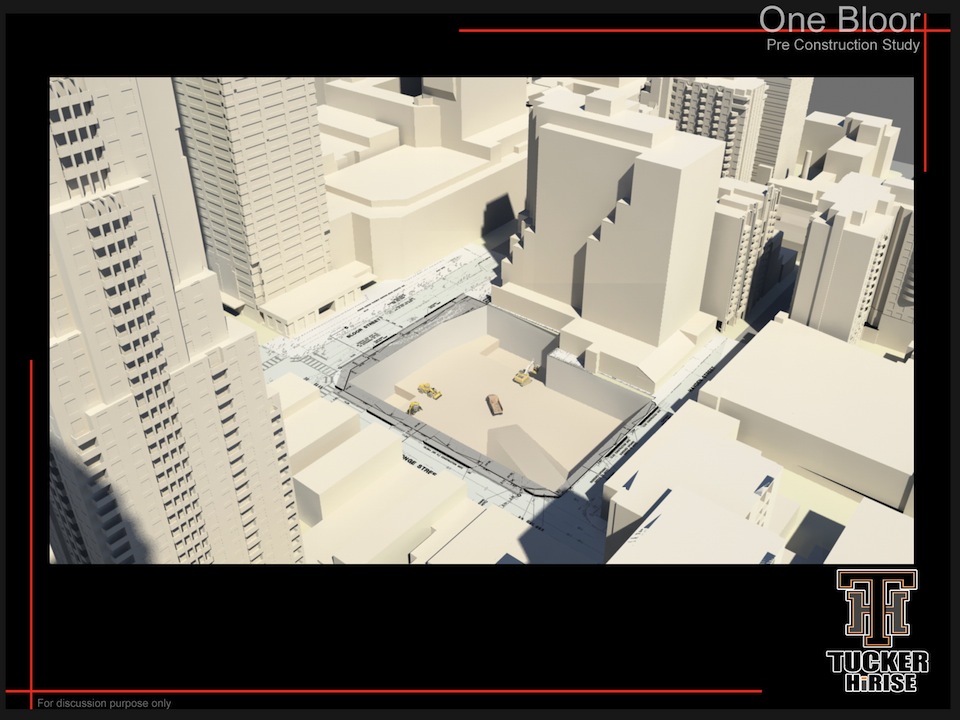 Rendering from pre-construction study of One Bloor, basement excavation. Image courtesy of Tucker Hi-Rise.
Rendering from pre-construction study of One Bloor, basement excavation. Image courtesy of Tucker Hi-Rise.
You have already worked through where clashes could occur then?
We've found clashes, and we created a process where we built a digital RFI. We run that by the consultants, get feedback from them, and the thing moves forward and adapts.
How much planning beforehand does this process actually require?
It's taken us about a year of planning in the sense that we're also learning some of the technologies because it's new. The software is actually all off the shelf, and we put together a few pieces of software in a package and manage it through, so it becomes process in addition to the actual technology.
For the overall construction timeline, how many fewer weeks of construction do you expect that this system will save you? Do you anticipate that it will be significant?
It certainly improves construction time and prevents many issues. The big problems in construction are often unexpected issues encountered during construction. It's like 50 hours in design, 500 hours in construction, so it eliminates those kinds of issues. It eliminates risk in terms of the schedule. It's not perfect, but we see the big things and we can adapt to them. We also incorporate some of our sub-trades into this process, so we can sit with our forming contractors, or our drywall contractors, and work through their work processes. One of the challenges of a building this high is getting workers up and down the building, so for that type of thing this is just invaluable, and the future of this technology is unbelievable.
 Rendering from pre-construction study of One Bloor, up to level 3. Image courtesy of Tucker Hi-Rise.
Rendering from pre-construction study of One Bloor, up to level 3. Image courtesy of Tucker Hi-Rise.
Have the sub-trades been receptive to using the new system with you?
Yes they have, but there is a buy-in time required. Sometimes people who are not familiar with the system look at it and it seems very cartoonish, but it's real time building, and they are buying in over time. There have been a couple situations where we created a video of the process, and we brought trades in and we showed them 'this is how we're going to dig the hole' and 'this is how we're going to do that process', and they're impressed. The feedback coming from that process is unbelievable. We're sitting there watching this and getting feedback from the trades, and we've actually changed the whole methodology of digging this hole because of that.
Is this the first time that you'll be using this system in Canada?
It's our first building, but we're rolling it out on other projects as well.
Describe what the difference will be in digging this hole, compared to another project which isn't using this system?
The challenge here is that we have a big core in the tower. When you dig a hole, sometimes you want to try to accelerate the tower out of the ground, and everything else can catch up. We've set up a methodology of inserting some temporary shoring, keeping the core clean, and trucks will go up around it. Instead of the big overburden of the ramp, it lets us keep that tight and the tower is going to come up more quickly.
So the entire tower basement doesn't have to reach ground level before you begin building the core upwards?
Probably what you will see here is the tower coming up as the core, and then everything else catching up. That's the plan. The great thing about this is that you have the critical path, and then you're able to adapt things as we go because we may see a different element come into the picture. One of the main issues here is street accessibility, trucking, and materials. It's a very very busy corner. We've dropped all of our street logistics into our model, and we actually model trucks coming in out, staging, and we have the drill rigs modelled to scale, moving around.
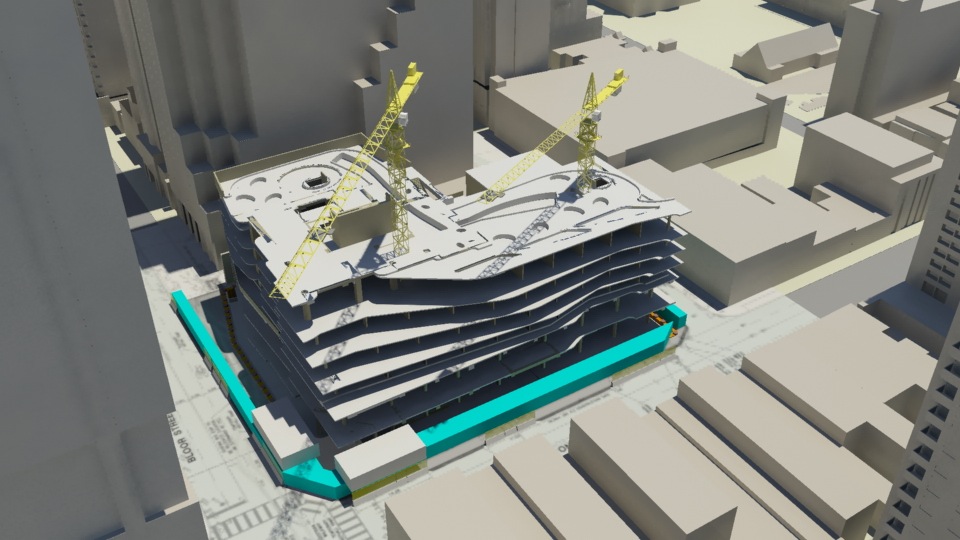 Rendering from pre-construction study of One Bloor, up to level 7. Image courtesy of Tucker Hi-Rise.
Rendering from pre-construction study of One Bloor, up to level 7. Image courtesy of Tucker Hi-Rise.
It's like a 3D Sim City?
Exactly, and that's where it's going. At some future time we'll be able to sit in front of a big screen with an architect in Australia or New York, an owner on a headset, and we'll be an avatar walking through. It will be the real building. It will be like taking the 2D working drawings, and just animating it. We're talking with Anna Simone of Cecconi Simone about the lobby of the project which is fairly detailed, and going to a level 500 just on that 2000-3000 sq foot area. A level 500/600 is very detailed, you're literally building it in VR. We have marble and various mill work coming together, and it's just as a beta project to see how far can we take this.
Thank you Michael for sitting down with us!
We leave you with a few more renders of anticipated construction milestones, courtesy of Tucker Hi-Rise.
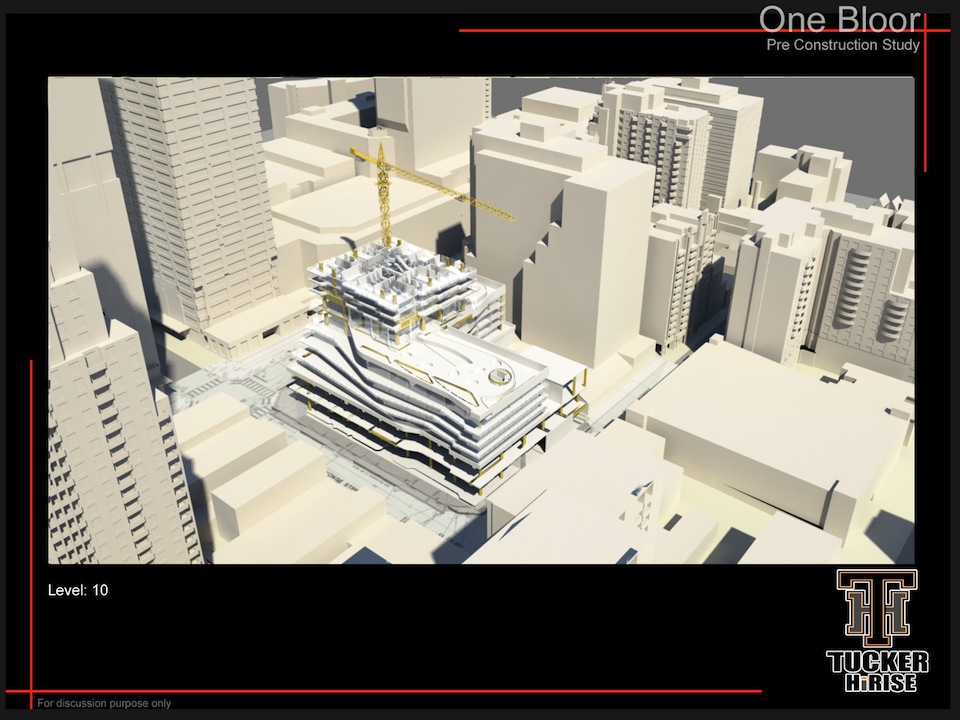 Rendering from pre-construction study of One Bloor, up to level 10. Image courtesy of Tucker Hi-Rise.
Rendering from pre-construction study of One Bloor, up to level 10. Image courtesy of Tucker Hi-Rise.
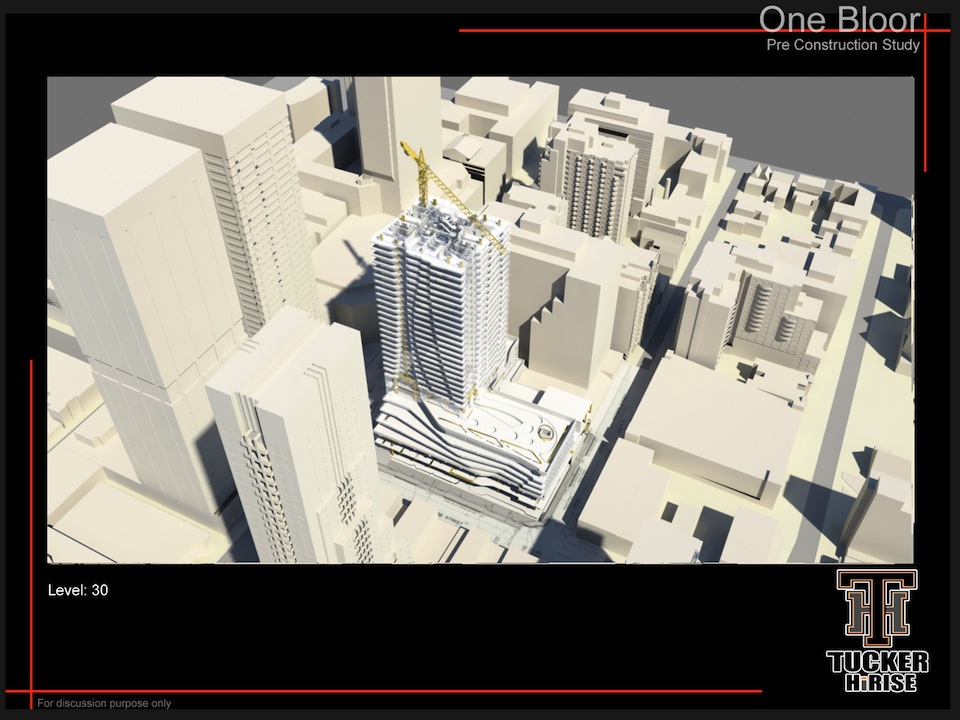 Rendering from pre-construction study of One Bloor, up to level 30. Image courtesy of Tucker Hi-Rise.
Rendering from pre-construction study of One Bloor, up to level 30. Image courtesy of Tucker Hi-Rise.
 Rendering from pre-construction study of One Bloor, up to level 50. Image courtesy of Tucker Hi-Rise.
Rendering from pre-construction study of One Bloor, up to level 50. Image courtesy of Tucker Hi-Rise.
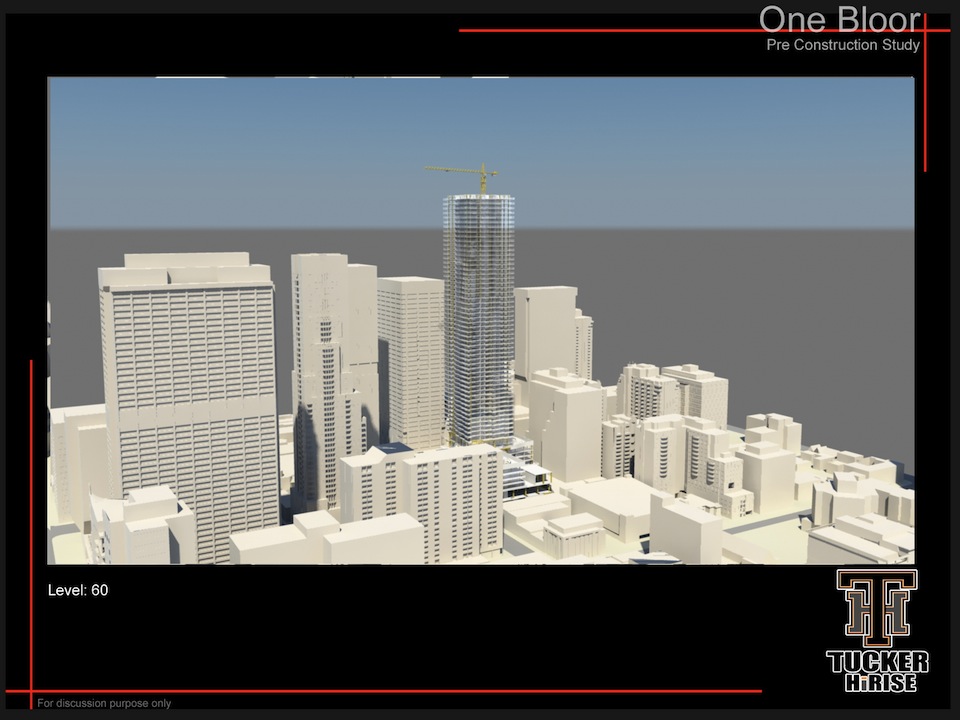 Rendering from pre-construction study of One Bloor, up to level 60. Image courtesy of Tucker Hi-Rise.
Rendering from pre-construction study of One Bloor, up to level 60. Image courtesy of Tucker Hi-Rise.
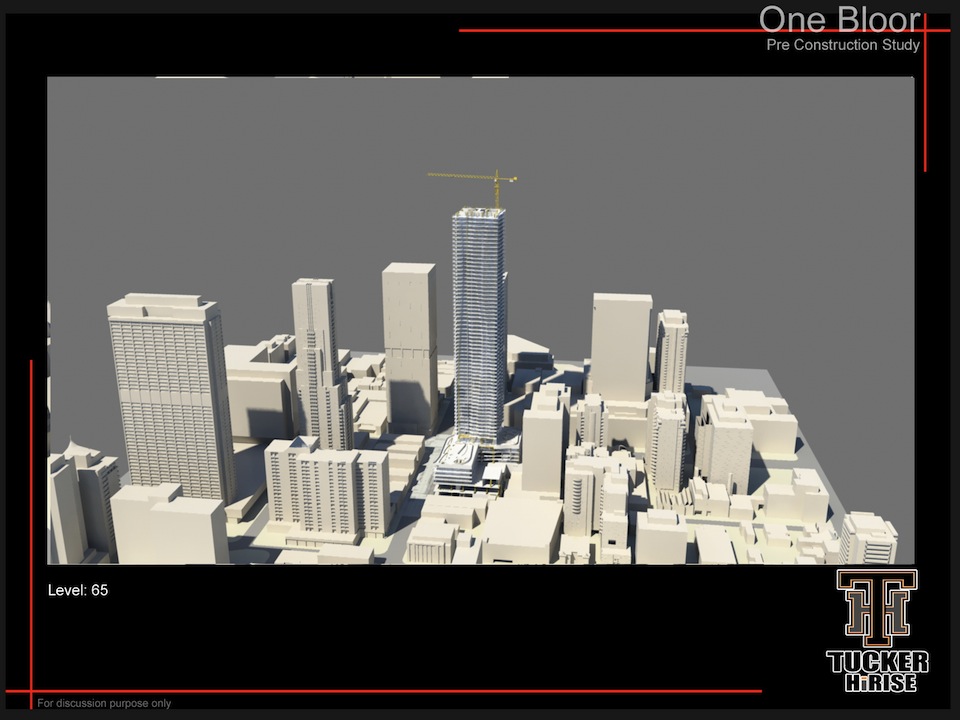 Rendering from pre-construction study of One Bloor, up to level 65. Image courtesy of Tucker Hi-Rise.
Rendering from pre-construction study of One Bloor, up to level 65. Image courtesy of Tucker Hi-Rise.
Want to talk construction? Leave a comment here, or click the link below to join in the discussion in the One Bloor Projects & Construction thread.

 2.3K
2.3K 



